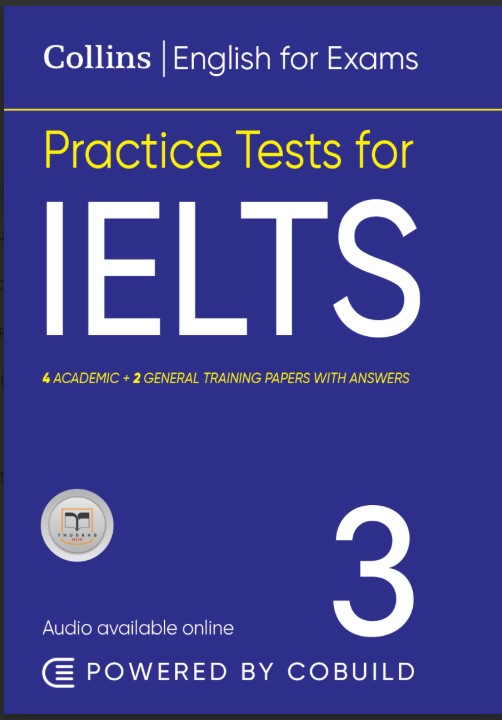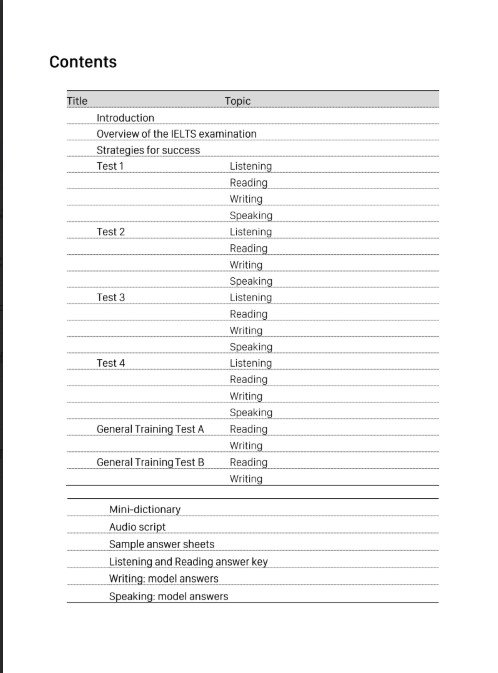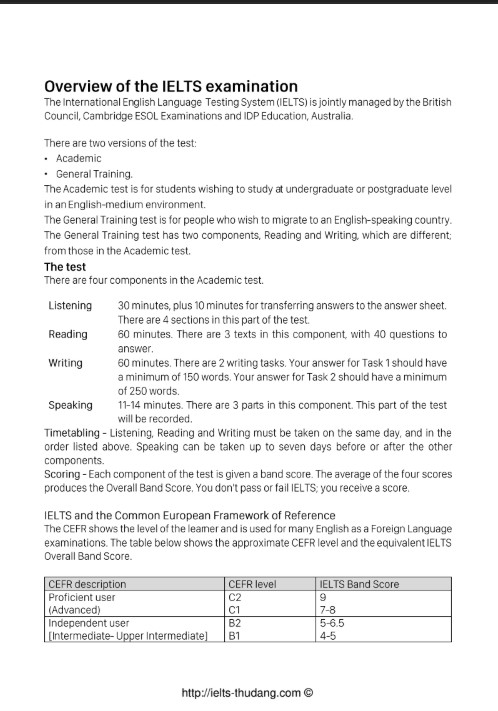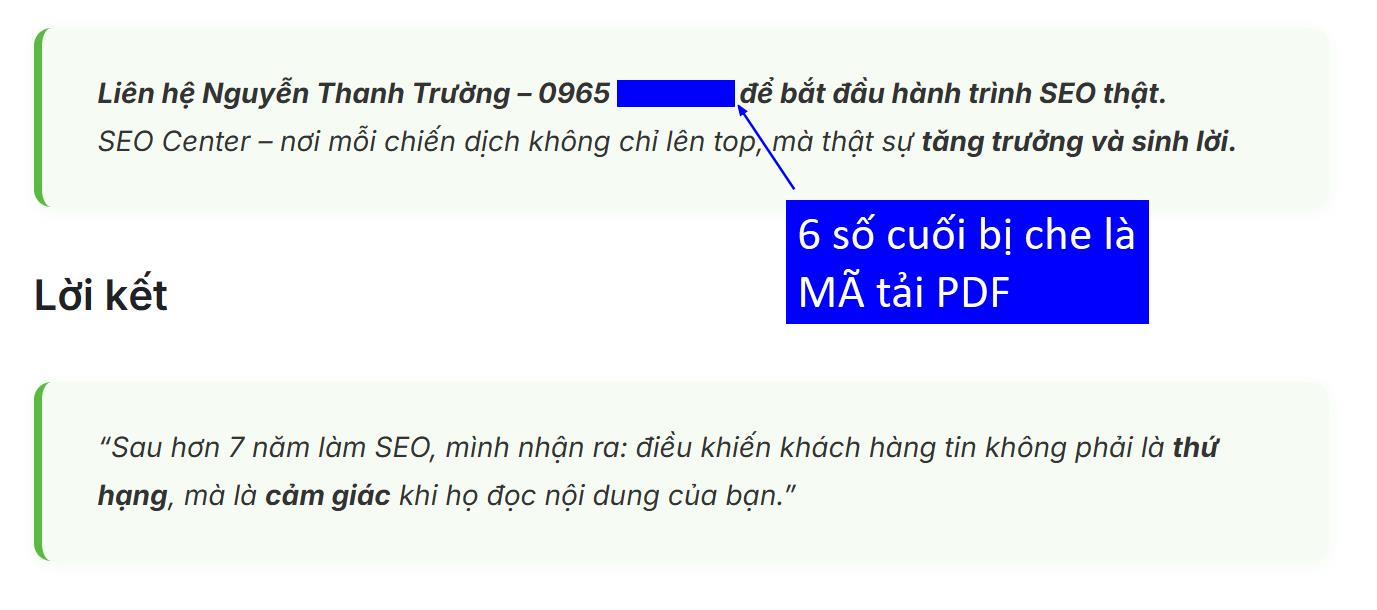


Hình 1: Contents
Contents
| Title | Topic |
| Introduction | |
| Overview of the IELTS examination | |
| Strategies for success | |
| Test 1 | Listening |
| Reading | |
| Writing | |
| Speaking | |
| Test 2 | Listening |
| Reading | |
| Writing | |
| Speaking | |
| Test 3 | Listening |
| Reading | |
| Writing | |
| Speaking | |
| Test 4 | Listening |
| Reading | |
| Writing | |
| Speaking | |
| General Training Test A | Reading |
| Writing | |
| General Training Test B | Reading |
| Writing | |
| Mini-dictionary | |
| Audio script | |
| Sample answer sheets | |
| Listening and Reading answer key | |
| Writing: model answers | |
| Speaking: model answers |
Hình 2: Overview of the IELTS examination
Overview of the IELTS examination
The International English Language Testing System (IELTS) is jointly managed by the British Council, Cambridge ESOL Examinations and IDP Education, Australia.
There are two versions of the test:
- Academic
- General Training.
The Academic test is for students wishing to study at undergraduate or postgraduate level in an English-medium environment.
The General Training test is for people who wish to migrate to an English-speaking country. The General Training test has two components, Reading and Writing, which are different from those in the Academic test.
The test
There are four components in the Academic test.
| Component | Time |
| Listening | 30 minutes, plus 10 minutes for transferring answers to the answer sheet. There are 4 sections in this part of the test. |
| Reading | 60 minutes. There are 3 texts in this component, with 40 questions to answer. |
| Writing | 60 minutes. There are 2 writing tasks. Your answer for Task 1 should have a minimum of 150 words. Your answer for Task 2 should have a minimum of 250 words. |
| Speaking | 11-14 minutes. There are 3 parts in this component. This part of the test will be recorded. |
Timetabling – Listening, Reading and Writing must be taken on the same day, and in the order listed above. Speaking can be taken up to seven days before or after the other components.
Scoring – Each component of the test is given a band score. The average of the four scores produces the Overall Band Score. You don’t pass or fail IELTS; you receive a score.
IELTS and the Common European Framework of Reference
The CEFR shows the level of the learner and is used for many English as a Foreign Language examinations. The table below shows the approximate CEFR level and the equivalent IELTS Band Score.
| CEFR description | CEFR level | IELTS Band Score |
| Proficient user (Advanced) | C2 | 9 |
| C1 | 7-8 | |
| Independent user | B2 | 5-6.5 |
| [Intermediate- Upper Intermediate] | B1 | 4-5 |
Hình 3: (Continuation of Overview)
This table contains the general descriptors for the band scores 1-9.
| Band Scores | Description |
| 9 | Expert user |
| 8 | Very good user |
| 7 | Good user |
| 6 | Competent user |
| 5 | Modest user |
| 4 | Limited user |
| 3 | Extremely limited user |
| 2 | Intermittent user |
| 1 | Non user |
| 0 | Did not attempt the test |
Marking
The Listening and Reading components have 40 items, each worth one mark if correctly answered. Here are some examples of how marks are translated into band scores.
Listening
- 16 out of 40 correct answers: band score 5
- 23 out of 40 correct answers: band score 6
- 30 out of 40 correct answers: band score 7
Reading
- 15 out of 40 correct answers: band score 5
- 23 out of 40 correct answers: band score 6
- 30 out of 40 correct answers: band score 7
The Writing and Speaking components are marked according to performance descriptors.
Writing – Examiners award a band score for each of four areas with equal weighting:
- Task achievement (Task 1)
- Task response (Task 2)
- Coherence and cohesion
- Lexical resource and grammatical range and accuracy
Speaking – Examiners award a band score for each of four areas with equal weighting:
- Fluency and coherence
- Lexical resource
- Grammatical range
- Accuracy and pronunciation
Hình 4: (Continuation of Overview)
This table contains the general descriptors for the band scores 1-9.
| Band Scores | Description |
| 9 | Expert user |
| 8 | Very good user |
| 7 | Good user |
| 6 | Competent user |
| 5 | Modest user |
| 4 | Limited user |
| 3 | Extremely limited user |
| 2 | Intermittent user |
| 1 | Non user |
| 0 | Did not attempt the test |
Marking
The Listening and Reading components have 40 items, each worth one mark if correctly answered. Here are some examples of how marks are translated into band scores.
Listening
- 16 out of 40 correct answers: band score 5
- 23 out of 40 correct answers: band score 6
- 30 out of 40 correct answers: band score 7
Reading
- 15 out of 40 correct answers: band score 5
- 23 out of 40 correct answers: band score 6
- 30 out of 40 correct answers: band score 7
The Writing and Speaking components are marked according to performance descriptors.
Writing – Examiners award a band score for each of four areas with equal weighting:
- Task achievement (Task 1)
- Task response (Task 2)
- Coherence and cohesion
- Lexical resource and grammatical range and accuracy
Speaking – Examiners award a band score for each of four areas with equal weighting:
- Fluency and coherence
- Lexical resource
- Grammatical range
- Accuracy and pronunciation


